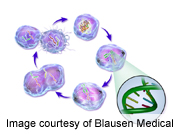
TUESDAY, May 8 (HealthDay News) — There is a great deal of genetic diversity in cells shed by cancerous tumors into the bloodstream, a new study has found.
Some cells have genes that enable them to lodge themselves in new locations, helping the cancer spread between organs, while other cells have different patterns of gene expression that might make them more benign or less likely to survive in other locations in the body.
Some circulating tumor cells even express genes that could predict their response to a specific cancer treatment, the researchers said.
“Within a single blood draw from a single patient, we’re seeing [varied] populations of circulating tumor cells,” senior study author Dr. Stefanie Jeffrey, chief of surgical oncology research at the Stanford University School of Medicine, said in a university news release.
The researchers said their findings highlight how multiple types of treatment may be needed to cure what appears to be a single kind of cancer and suggest that the current cell-line models of human cancers need to be improved upon.
The study, which used blood samples from breast cancer patients, is the first to look at circulating tumor cells one by one instead of taking the average of many of the cells. It also is the first to show the extent of genetic differences between circulating tumor cells, the researchers said.
Scientists have long known that circulating tumor cells move through the bloodstreams of cancer patients. Over the past five years, though, many cancer researchers have begun to think the cells could be the key to tracking tumors noninvasively.
The study appears online Tuesday in the journal PLoS One.
More information
The U.S. National Cancer Institute has more about cancer.

